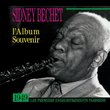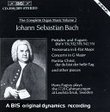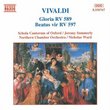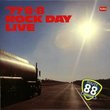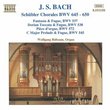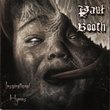| All Artists: Franz Joseph Haydn, Bela Drahos, Budapest Nicolaus Esterhazy Sinfonia, Nicolaus Esterhazy Sinfonia Title: Haydn: Symphonies Vol. 12, Nos. 69 "Laudon", 89 & 91 Members Wishing: 0 Total Copies: 0 Label: Naxos Release Date: 6/28/1994 Genre: Classical Styles: Historical Periods, Classical (c.1770-1830), Symphonies Number of Discs: 1 SwapaCD Credits: 1 UPCs: 730099576925, 4891030507692 |
Search - Franz Joseph Haydn, Bela Drahos, Budapest Nicolaus Esterhazy Sinfonia :: Haydn: Symphonies Vol. 12, Nos. 69 "Laudon", 89 & 91
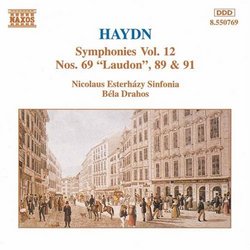 | Franz Joseph Haydn, Bela Drahos, Budapest Nicolaus Esterhazy Sinfonia Haydn: Symphonies Vol. 12, Nos. 69 "Laudon", 89 & 91 Genre: Classical
|
Larger Image |
CD DetailsSimilar CDs
|
CD ReviewsExploring the Haydn Symphonies -- No. 69,89, and 91 Robin Friedman | Washington, D.C. United States | 05/28/2005 (4 out of 5 stars) "This CD offers a welcome opportunity to hear three of the lesser-known Haydn symphonies -- including two from the years of Haydn's full maturity that produced the "Paris" and the "London" symphonies. The works are performed by the Nicolaus Esterhazy Sinfonia conducted by Bela Drahos as part of a projected complete recording of the Haydn symphonies on the budget-priced Naxos label. The performances are good if not outstanding. The attraction of this CD lies in hearing unfamiliar Haydn. I will begin with the two latter symphonies.
As the reviewer below notes, the sympnony no. 91 in E-flat major is a gem. This symphony dates from 1788-89 and shows a more introspective, lyrical and subtle style than we usually associate with Haydn. The work has the character of a wistful dance. The first movement opens with a slow introduction which Haydn works beautifully into the opening allegro assai. The movement features a gentle legato theme and a dancelike second theme. Both the themes are closely linked with the opening largo. This is a beautifully integrated movement. The second movement, andante, is also highly original. It consists of a set of three variations on a detached, whimsical theme. Listen to the bassoon and the accompanying string filigree in the first variation and the series of trills near the end of the movement. The minuet is flowing and graceful with a dancelike trio in the bassoon accompanied by plucked strings. The finale opens quietly and builds gradually to a strutting and confident close. It is worth contrasting this graceful, lovely work in E-flat major to the broad, heroic works Beethoven wrote in this key, such as the "Eroica" symphony and the "Emperor" concerto. The symphony no. 89 in F major frequently suffers by comparison with the companion symphony no. 88 in G major, one of Haydn's finest works. But this work has charms of its own and shows much of Haydn's ingenuity as a composer. In this symphony, as stated in the Oxford Composer Companion to Haydn, (p.401) "vigour is tempered by elegance". The first movement, vivace, opens with five stacatto chords followed by a flowing melody. Those familiar with musical structure will notice something highly unusual in this movement. There is no recapitulation per se. After the opening exposition, Haydn proceeds to vary and develop his themes, but he only gets to what would appear to be the development section at the conclusion of the movement. The work, as is so much of Haydn, is full of surprises. With this ingenious movement, we can understand perhaps why Haydn borrowed from an earlier composition in the second and fourth movement of this symphony. Both these movements are taken from a "Concerto for Lira Organizzta" that Haydn composed in 1786, two years before this work, for the King of Naples. The second movement is a siciliene in 6/8 with a flowing theme. The finale starts quickly and includes an unusual musical marking -- strascinado -- which instructs the performers to drag the beginning of the opening theme. This isn't done with much emphasis on the CD. The third movement is a minuet in which the winds have the predominant role. There is a lovely flute solo in the trio. The final work on this CD is the symphony no. 69 which dates from about 1778. The work is called "Laudon" because Haydn dedicated it to a military hero whose name was acutally Loudon. The work is in C major which, for Haydn, is the key of flash and flamboyance. The opening movement is marked vivace and features a contrast between a marchlike opening with large chords and a softer second theme. There is extensive use of brass. The second movement features the strings in a flowing theme with a darker-hued middle section. The minuet is one of stateliness and pomp where the trumpets return and give a military character to the movement. The finale, vivace assai, opens quietly but soon develops to a vigourous conclusion. Haydn omitted this finale in reduction of this symphony he prepared for the piano. In doing so, he tartly observed to his publisher that the dedication to war hero Laudon was "worth more than ten finales". This CD will appeal to listeners who love early classical music and who want to hear more of Haydn than the handful of frequently-performed symphonies." |

 Track Listings (12) - Disc #1
Track Listings (12) - Disc #1

